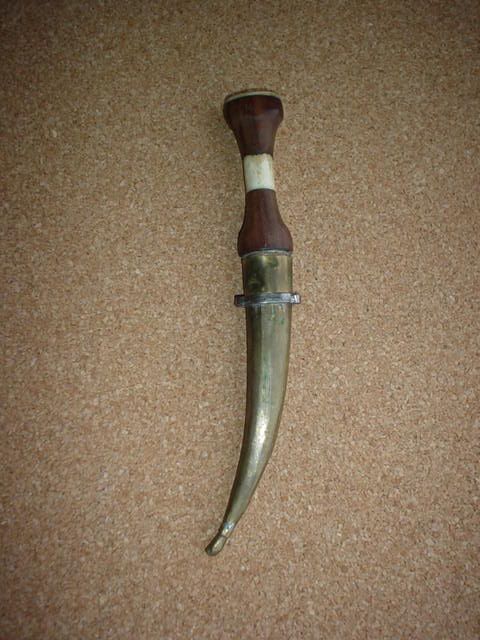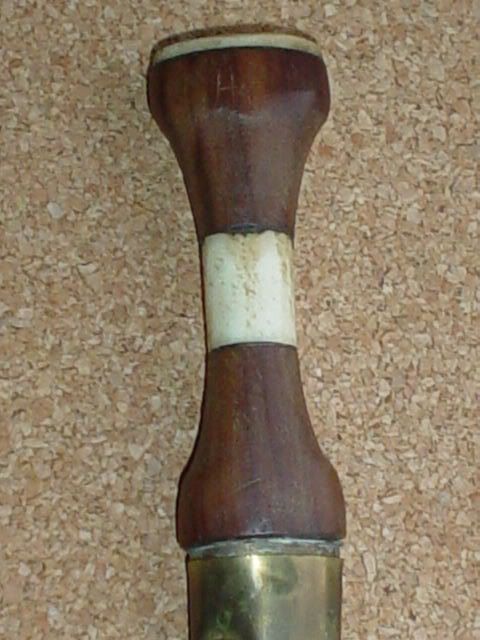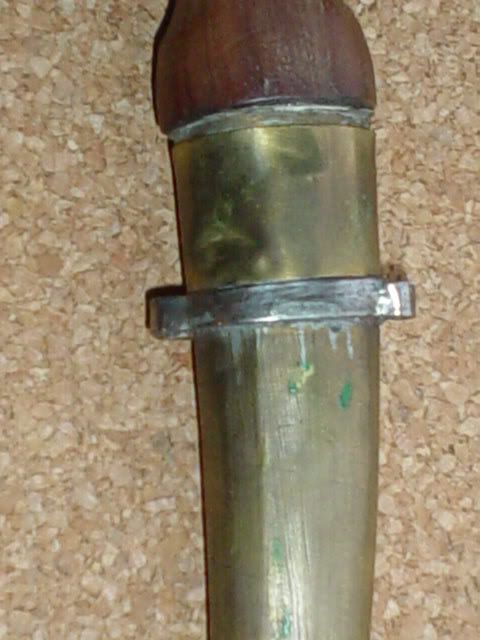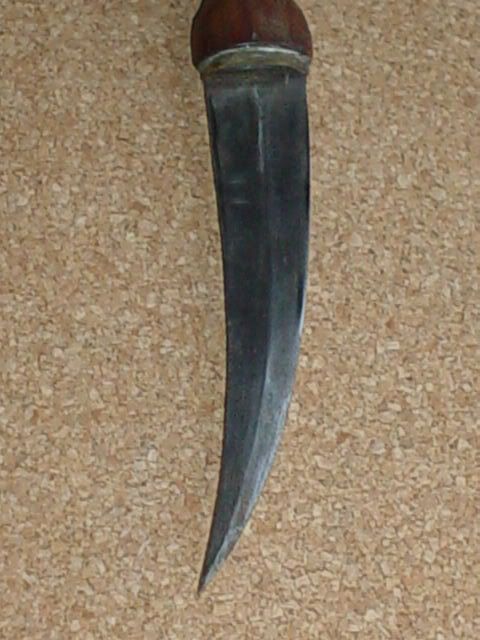
 |
|
|
#1 |
|
Member
Join Date: Mar 2005
Posts: 306
|
Greetings To All Forum Members,
Depicted is a recent find that I suspect may either be of Lebanese or Syrian origin based on it's appearance. The hilt is made od of black plastic with colored plastic inlay. The sheath and part of the dagger are made of cast brass plated with silver. The sheath exhibits two zinc loop rings. I was wondering if this would be worn like a Moroccan Koummya ? On the front of the sheath, there is what appears to be Arabic script. If anyone can assist in it's translation it would be most appreciated. At the throught of the dagger sheath there is a cardboard or leather insert. I believe this to be a 'touist dagger' possibly from the '40's or 50's but handmade. Any input would be most welcomed and appreciated ! Thank you in advance for any assistance any of you may be able to provide ! Mark... seven11@epix.net.. |
|
|

|
|
|
#2 |
|
Member
Join Date: Mar 2005
Posts: 306
|
Hi all!
I belive the writing on the sheath translates to"allah",but this is only a guess. Can anyone help me with it's origens as either Syrian or Lebanese. Please any help whould be appreciated Last edited by Aurangzeb; 21st May 2005 at 04:29 PM. |
|
|

|
|
|
#3 |
|
Member
Join Date: Dec 2004
Posts: 184
|
I think I have mainly seen these billed as Lebonese and the ones with mosaic hilts billed from Syria but I suspect that both of these may very well come from both places.
Here is a majdali dagger from Syria to illustrate: |
|
|

|
|
|
#4 |
|
Member
Join Date: Dec 2004
Posts: 215
|
Hi Justin,
The example you show is from the Golan Heights area. Many were made during the French occupation of Syria (1941-46), but they are still made for sale to tourists. I have owned a few of the older ones and they usually have some kind of poem in arabic on the blade, frequently "funny" but with violent intent. It would take a while to dig up some translations but they were all along the same lines. It reminds me of the poems or phrases on Mexican knives. The first knife here is from the same general region, but would probably be recognized as a completely different style locally. -d |
|
|

|
|
|
#5 |
|
Member
Join Date: Mar 2005
Posts: 306
|
Hi all!
Thanks for helping me fighure out which of the two countries it was from. I wonder if the three stars mean anything? Perhaps the 3 stars on the old syrian flag,not the 2 star one of today. Last edited by Aurangzeb; 22nd May 2005 at 12:13 AM. |
|
|

|
|
|
#6 |
|
Member
Join Date: Dec 2004
Posts: 215
|
Three stars like the old flag sounds likely, but I don't know. I did find one of my old pics with an assortment from the same area.
|
|
|

|
|
|
#7 |
|
Member
Join Date: Mar 2005
Posts: 306
|
Hi all!
Thanks again with all the help with the I.D. of the dagger.I think your estimate of it's age is most likelky,I came to my conclusion of it's age off the origenal auction. Soon I hope to post a Omani khanjar. |
|
|

|
|
|
#8 |
|
Member
Join Date: Dec 2004
Location: Sint-Amandsberg (near Ghent, Belgium)
Posts: 830
|
Hi,
I think this dagger fits into the same category. Nevertheless, it could also be a kind of copy found in the interior of Africa. I would appreciate any comment.       I found this one on ebay and bought it really cheap. At first, I thought it was a simple tourist version. But the handle which is made of wood and bone (don't think it's ivory) and the blade made me reconsider. The blade is sharp and has a strong middle rib. Although the sheat is simple with no decoration, the fit is very tight. The knife doesn't 'rattle' in its scabbard as with the normal tourist pieces. I think the origin could be Central Africa due to the very simple design. Total lenght : 29,5 cm Lenght of blade : 15 cm |
|
|

|
|
|
#9 |
|
Member
Join Date: Mar 2005
Posts: 306
|
Hi all!
Two last questions about my Syrian dagger. First,is this worn in a similer fashion to the koummya of Morroco? Second,Although not arms or armour related is important to me anyway,do they were/used to wear fez hats in Syria? I believe that my dagger might be a 1950's torist dagger due to the fact that the blade is not very sharp but is only a little sharper than a butterknife, and is only sharp at the point. It also rattles slghtly in it's sheath, which at it's throat only has a cardborad or leather insert. Hopefully someone can translate the word on the sheath.  Thanks again for the help. P.S.- Freddy your dagger reminds me slightly of a Jordanian jambiya(not shabria) I saw recently. P.S.- someone told me that a acrilic spray might be good at preserving a dagger,is this wise or not? |
|
|

|
|
|
#10 |
|
Member
Join Date: Mar 2005
Posts: 306
|
Hi all!
So this means that nobody on here can translate the inscription on my dagger? (I hope it don't mean this) |
|
|

|
|
|
#11 |
|
Member
Join Date: Feb 2005
Location: Clearwater, Florida
Posts: 371
|
Sometimes all that can be done is to bump a thread a few times until one of the members that can translate the inscription pops in, Aurangzeb, with another choice being to do a search on translations and then e-mail the photo directly to one of the members that's been of assistance with that language in the past.
It can be frustrating when members are on vacation or otherwise occupied, but many to most are willing to assist when they can. Mike |
|
|

|
|
|
#12 |
|
Member
Join Date: Mar 2005
Posts: 306
|
Hi Mike!
I understand what your saying,The one person I know off of the this forum who speaks arabic is away on buissness.(If it were not for badluck I whould have no luck at all!  )Thanks for the advice. )Thanks for the advice.P.S.-more bad luck my one freind who went to the Demo.Republic of the Congo chould find no daggers,even if he did the country is under quarentine. 
|
|
|

|
|
|
#13 |
|
Member
Join Date: Mar 2005
Posts: 306
|
Hi all!
Whould this dagger be worn like a koummya? Any help whould be appreciated. |
|
|

|
|
|
#14 |
|
Member
Join Date: Dec 2004
Location: Houston, TX, USA
Posts: 1,254
|
Freddy, I wonder if your dagger might be from Somaliland or Ethiopia. The metal "guard" and the overall shape of the handle, as well as the use and placement of the bone spacer, are similar to what's seen on billao. What is the nonsymetrical knob at the sheath tips? I see this swoopy curved pointy knob on sheath tips, and sometimes at the ends of quillons. What is known of its meaning or regionality?
|
|
|

|
|
|
#15 |
|
Member
Join Date: Dec 2004
Posts: 184
|
I would personally advise against the acryllic spray idea,alot of that stuff just makes a mess and can be very difficult to remove.
|
|
|

|
|
|
#16 |
|
Member
Join Date: Mar 2005
Posts: 306
|
Hi Justin!
Thanks for the advise about the acryllic spray. |
|
|

|
|
|
#17 |
|
Member
Join Date: Dec 2004
Location: Houston, TX, USA
Posts: 1,254
|
Yeah, don't do it. It won't stick anyway to a previously oiled blade unless you degrease it, and I must say that in contrast to gloppy silver and gold paint, blades that have been lacquered (one does encounter it fairly frequently, with yellowed or red-faded old lacquer; it seems to have been popular with English and Euro-North Americans in the early and mid 20th) are usually fairly easy to clean off (but modern spray acryllic might well be more difficult), and it does seem to have a certain preservative power (so do the ugly metallic paints, but they can be SOOOO hard to get off!
   ). If the laquer seperates from the metal, as it sometimes does, then the pocket underneath becomes like a little moisture chamber, though. I think you're better to stick with waxes and oils; cosmoline seems real good for longterm storage (is that commercially available? Is it truly as same as drugstore petroleum jelly as it seems?).........I like a plated blade (though others don't), but that's not a realistic after-market protection for an assembled sword or anything......too long winded; oil and/or wax. Microcrystaline wax, like "Rennaissance Wax" or some fancy car waxes, is usually recommended, as the danger is not just from large packets of water that will bead up on ordinary wax, but from water vapor in the air, acting at a smaller level of reality. Alternately, good gun oils with Teflon or graphite that claim to leave behind a microscopic protective layer usually work fairly well, too, although they rub off easily and must be reapplied. I've heard of using bicycle lubricant, too, but know nothing specific there. ). If the laquer seperates from the metal, as it sometimes does, then the pocket underneath becomes like a little moisture chamber, though. I think you're better to stick with waxes and oils; cosmoline seems real good for longterm storage (is that commercially available? Is it truly as same as drugstore petroleum jelly as it seems?).........I like a plated blade (though others don't), but that's not a realistic after-market protection for an assembled sword or anything......too long winded; oil and/or wax. Microcrystaline wax, like "Rennaissance Wax" or some fancy car waxes, is usually recommended, as the danger is not just from large packets of water that will bead up on ordinary wax, but from water vapor in the air, acting at a smaller level of reality. Alternately, good gun oils with Teflon or graphite that claim to leave behind a microscopic protective layer usually work fairly well, too, although they rub off easily and must be reapplied. I've heard of using bicycle lubricant, too, but know nothing specific there.
|
|
|

|
|
|
#18 |
|
Member
Join Date: Mar 2005
Posts: 306
|
Hi Tom!
I just bought a nice Afghan choora off e-bay with a lacquered blade that has begun to peel, it should be a real treat to get off. 
|
|
|

|
|
|
#19 |
|
Member
Join Date: Feb 2005
Location: Clearwater, Florida
Posts: 371
|
Acetone often takes off old antique laquer with extreme ease in only minutes.....I too recently aquired a laquered Afghan Khyber knife, and it was clean in less than 5 minutes with no effort.
DO work in an open or well ventilated area though, as it's extremely bad to inhale (no matter how good you might feel for a few moments) **grin** By the way, for those of you not familiar with buffalo horn, often that's what's mistaken for "black plastic" as it does have a superficial resemblance...it's extremely common on Arabic and middle eastern knives, swords and daggers as a hilt material. Mike |
|
|

|
|
|
#20 |
|
Member
Join Date: Mar 2005
Posts: 306
|
Hi Conogre!
Thanks for the help I be sure to try it as soon as I get it. Most of those cleaners smeel absolutly horrid. I have a type of glue that makes my eyes water just being around an opean tube, can't possibly be good for anyone. |
|
|

|
|
|
#21 |
|
Member
Join Date: Feb 2005
Location: Clearwater, Florida
Posts: 371
|
Not good is an understaement, with many solvents known carcinogens of the worst kind, and sadly, they are often abused as "inhalents" by teens, sometimes with fatal results.
By the way, many of these knives are indeed worn thrust through the sash like the typical jambiya, while some scabbards have rings and are worn as we would wear a belt knife, usually with ornate fabric baldrics. To "restore" these for dispaly you can get curtain tie-back ropes in many better fabric stores that often have an elaborate knot on the ends, much like the originals and with a very impressive end result. Mike |
|
|

|
 |
|
|